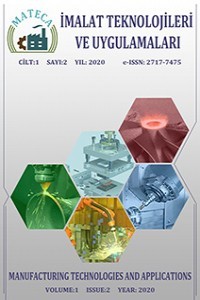Al-NiAl Kompozitlerin Korozyon Davranışlarının İncelenmesi
Aluminyum, NiAl partikül, Korozyon
Investigation of Corrosion Behaviors of Al-NiAl Composites
Aluminium, NiAl Particles, Corrosion,
___
- A.Lekatou, A.E. Karantzalis, A. Evangelou, V. Gousia, G. Kaptay, Z. Gácsi, P. Baumli and A. Simon, Aluminium reinforced by WC and TiC nanoparticles (ex-situ) and aluminide particles (in-situ), Microstructure, wear and corrosion behaviour, Materials and Design, 65: 1121–1135 (2015).
- H. Çuğ and M. E. E. Erhaima, Effect of Mn and Zr Addition on Microstructure, Wear and Corrosion Behavior of Ti-6Al-4V Composite Biomaterials Produced by Powder Metallurgy, Manufacturing Technologies and Applications, 2 (2): 41-48 (2021).
- S. Candan, An investigation on corrosion behaviour of pressure infiltrated Al–Mg alloy/SiCp composites, Corrosion Science, 51: 1392–1398 (2009).
- K. H. W. Seah, M. Krishna, V. T. Vijayalakshmi and J. Uchil, Corrosion behaviour of garnet particulate reinforced LM13 Al alloy MMCs, Corrosion Science, 44: 917–925 (2002).
- S. Candan, Effect of SiC particle size on corrosion behavior of pressure infiltrated Al matrix composites in a NaCl solution, Mater Letters, 58(27-28): 3601–3605 (2004).
- ASTM G102-89, Standard practice for calculation of corrosion rates and related information from electrochemical measurements, ASTM International, 2004.
- ASTM G 31-72, Standard practice for laboratory immersion corrosion testing of metals, ASTM International, 1990.
- M. Conserva, G. Donzelli and R. Trippodo, Aluminum and Its Applications, Edimet, Brescia, 1992.
- B. Grushko, S. Mi, J.G. Highfield, A study of the Al-rich region of the Al–Ni–Mo alloy system, Journal of Alloys and Compounds, 334 (1-2): 187–191 (2002).
- A. Taylor and N. Doyle, Further studies on the nickel–aluminium system. I. βNiAl and δ-Ni2Al3 phase fields, Journal of Applied Crystallography, 5(3): 201–209 (1972).
- H. M. Zakaria, Microstructural and corrosion behavior of Al/SiC metal matrix composites, Ain Shams Engineering Journal, 5(3): 831-838 (2014).
- Yayın Aralığı: Yılda 3 Sayı
- Başlangıç: 2020
- Yayıncı: Mustafa GÜNAY
ALÜMİNYUM 7075-T6 MALZEMENİN ISI DESTEĞİ İLE İŞLENEBİLİRLİĞİNİN İNCELENMESİ
Ümit KARABUĞA, Şener KARABULUT, Abdulkadir GÜLLÜ
Al-NiAl Kompozitlerin Korozyon Davranışlarının İncelenmesi
Hüseyin DEMİRTAŞ, Ramazan YILDIZ, Engin ÇEVİK
Ayşegül ÇAKIR ŞENCAN, Muhammet ÇELİK, Ekin Nisa SELAYET SARAÇ
Dövme ve Döküm Alüminyum Alaşımlarının İşlenmesinde Takım Aşınması: Literatür Araştırması
Cem ALPARSLAN, Şenol BAYRAKTAR
Orta ve İleri Düzey Robotik Kodlama Eğitimleri için İnternet Odaklı Sensör Kartı Tasarım ve İmalatı
